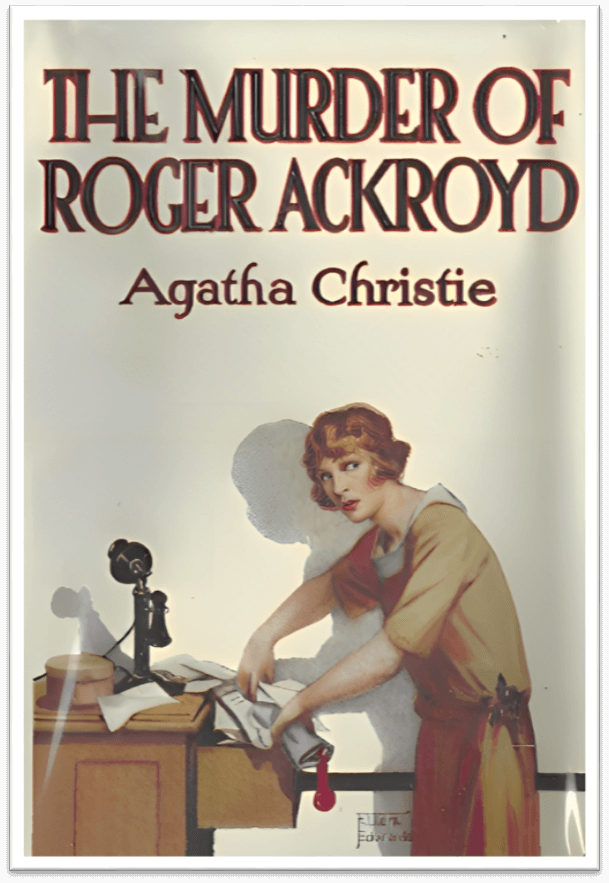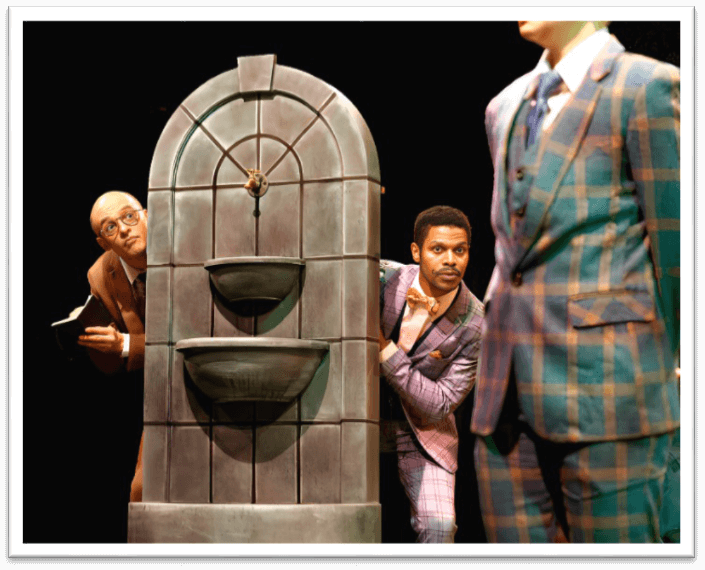The Murder of Roger Ackroyd Summary
Introduction
Agatha Christie's classic detective book "The Murder of Roger Ackroyd" was released in 1926. It follows Hercule Poirot, Christie's renowned detective, as he looks into the slaying of a wealthy businessman named Roger Ackroyd in a small English village. The book is renowned for its clever narrative turn, which stunned readers when it was first published and has since become one of the most well-known and contentious conclusions in the annals of mystery fiction. The book is being read today and is still acknowledged as a classic in its field.
Importance of the Novel in the Mystery Genre:
Due to several factors, "The Murder of Roger Ackroyd" is regarded as a classic in the mystery genre. First, it is one of the earliest examples of the traditional "whodunit" story, in which readers are given a problem to solve alongside the detective. This style quickly gained enormous traction and has since established itself as a standard in the mystery genre.
The book is also renowned for its deft plot twist, which has become a trademark of Christie's writing and surprises readers. Since the novel's release, numerous writers have imitated and modeled their plot twists after it.

Plot Summary:
I. Setting and Characters:
The 1920s are shown in "The Murder of Roger Ackroyd" in the peaceful English village of King's Abbot. Dr. James Sheppard, a local physician with his single sister Caroline, tells the tale.
The small and close-knit group of people in the book reflects the community-based essence of village life. Principal figures include:
- Hercule Poirot - the renowned detective hired to investigate Roger Ackroyd's slaying.
- Roger Ackroyd - A successful businessman who announced his engagement to Mrs. Ferrars just before being discovered dead in his study.
- Mrs. Ferrars - Former lover of Roger Ackroyd who passed very suddenly, maybe from an overdose, just before the book starts.
- Ralph Paton - Stepson of Roger Ackroyd, who is accused of robbing his stepfather of money but eventually reveals a more sinister connection to the killing.
- Flora Ackroyd - A key suspect in the murder inquiry is Roger Ackroyd's niece and fianc�e.
- James Sheppard - The story's narrator, who gets involved in the investigation after learning of his friend Roger Ackroyd's death.
- Caroline Sheppard - James' nosy and gossipy sister- is an incredible asset to Poirot's inquiry.
These people make up the web of connections and motives that Poirot must unravel to uncover the truth about Roger Ackroyd's murder. A small group of additional suspects and witnesses joins them.

II. Initial Events Leading Up to the Murder:
- The events before Roger Ackroyd's murder are important to the novel's plot. In a letter from Mrs. Ferrars, Roger Ackroyd's old lover, she confesses to poisoning her husband, and Roger Ackroyd tells his friend Dr. James Sheppard about it before he passes away. Due to Mrs. Ferrars' recent apparent overdose death, which many believe to have been a suicide, the discovery is noteworthy.
- Roger Ackroyd is discovered dead in his study shortly after this talk, with a letter opener stab wound to the neck. Ralph Paton, Ackroyd's stepson, who has vanished and is suspected of stealing money from his stepfather, quickly attracts suspicion. Poirot, however, is certain that the issue is more complicated than it appears and starts looking into the other potential candidates.
- The investigation is made more difficult by the fact that many of the suspects, including Flora Ackroyd, who was engaged to Roger at the time of his death, and Mrs. Cecil Ackroyd, Roger's widow and the potential beneficiary of a sizeable inheritance, have their secrets and motivations. To discover the truth behind Roger Ackroyd's murder, Poirot must dig through a labyrinth of deception and falsehoods.

III. The Discovery of Roger Ackroyd's Body:
- A key scene in the book occurs when Roger Ackroyd's death is found; it establishes the context for what happens next, which is the inquiry. The maid calls Dr. James Sheppard, who lives next door to Ackroyd, to the location after discovering the dead there. Sheppard quickly calls the police, and they show up to start their inquiry.
- Given that Roger Ackroyd was a well-liked resident of the community, the discovery of the death shocks the locals. Poirot first gathers evidence to begin his investigation and interviews the main suspects. The killer's letter opener, used to kill Ackroyd, was discovered in the adjoining summerhouse and is considered the most important evidence.
- The body's discovery raises many concerns about the killer's intent and tools. Given that the letter opener was discovered in the summerhouse, it's possible that the murderer was familiar with the house's layout. As he attempts to put the circumstances surrounding the murder together, Poirot's research progressively reveals a web of fabrications and dishonesty among the suspects.
IV. The Investigation and Key Suspects:
- Hercule Poirot, the renowned investigator who is hired to crack the case in "The Murder of Roger Ackroyd," is in charge of the inquiry. Poirot starts by questioning the main suspects, including staff and family members of Roger Ackroyd.
- One of the main suspects is Ralph Paton, Ackroyd's stepson, who has vanished and is suspected of stealing money from his stepfather. Mrs. Cecil Ackroyd, Roger's widow who will receive a sizable inheritance, and Flora Ackroyd, Roger's niece and fianc�e, are suspected of the crime.
- As Poirot continues his investigation, he learns that each suspect has a reason for wanting Roger Ackroyd dead. Flora Ackroyd may have murdered her uncle to save her love for Ralph Paton. It's possible that Mrs. Cecil Ackroyd wanted him out of the way so that they could continue their romance with her husband's business partner. Ralph Paton is suspected of robbing his stepfather of money and may have murdered him to hide the robbery.
- Many suspects are dishonest and have secrets, so Poirot's investigation is difficult. Poirot uses his renowned "little grey cells" to gather the facts and determine what happened when Roger Ackroyd was killed. In the end, Poirot discovers something unexpected about the killer, which sets up one of the most well-known narrative turns in the annals of the mystery genre.

V. The Unveiling of the Killer and the Twist Ending:
- The most significant elements of "The Murder of Roger Ackroyd" are the identification of the murderer and the shocking conclusion. Poirot's investigation throughout the book leads him to conclude that the killer is one of the main suspects, along with Mrs. Cecil Ackroyd, Flora Ackroyd, and Ralph Paton.
- However, Poirot discloses that the murderer is Dr. James Sheppard, Poirot's close friend, and narrator, in the book's concluding pages. This information was not previously known. Poirot says that Sheppard was responsible for Mrs. Ferrars' demise and killed Roger Ackroyd to keep him from learning the truth.
- One of the most well-known plot twists in the annals of the mystery genre is the unexpected revelation that Sheppard is the murderer. Sheppard is not only the murderer but also the narrator of the narrative. This causes readers to reevaluate what they believe is true regarding the circumstances leading up to the murder.
- Agatha Christie's skillful use of twist endings in her stories has made "The Murder of Roger Ackroyd" a mystery genre classic. It has innumerable copies and adaptations in the years since it was published, and readers are still enthralled by it today.

Analysis of Key Themes:
I. Deception and Betrayal:
The themes of deception and betrayal are prevalent in "The Murder of Roger Ackroyd." Characters commit a variety of lies and betrayals throughout the book, which adds to the intricate web of reasons and suspects.
- Deception Among the Suspects: Numerous suspects, including Flora Ackroyd, Mrs. Cecil Ackroyd, and Ralph Paton, act dishonestly. They conceal their genuine intentions, offer phony justifications, and withhold critical information from the investigators. Poirot finds it difficult to uncover the truth because of their behaviors, which foster a climate of suspicion.
- Narrator's Deception: The narrator, Dr. James Sheppard, withholds crucial information from the audience. As the plot develops, it becomes clear that Sheppard committed the murder and has been twisting the truth to cover up his guilt. His dual status as the murderer and storyteller adds another layer of deception and challenges the reader's faith in the narrative.
- Betrayal of Trust: The issue of betrayal in relationships is explored throughout the book. Characters betray one another, revealing hidden intentions and secrets. For instance, Mrs. Ferrars' confession letter exposes her confidence in Roger Ackroyd, ultimately leading to his homicide. The ties between the individuals are interwoven, and the following betrayals heighten the story's emotional impact and intrigue.
Agatha Christie puts readers' faith in the people and their motivations to the test through these instances of deceit and betrayal. The subject of deception heightens the suspense, complicates the plot, and keeps readers interested in working together to solve the mystery. Sherlock Holmes

II. The Nature of Truth:
"The Murder of Roger Ackroyd" explores the nuanced nature of reality, emphasizing how appearances may be deceptive and how the truth is frequently not what it seems. The book tests the readers' assumptions and shows how contradictory truths coexist.
- Subjective Truth: The story tackles the notion that truth is arbitrary and open to the influence of personal viewpoints. Each character has their interpretation of the events and their truths, which are frequently molded by their prejudices, motivations, and hidden intentions. Poirot must work through these subjective truths to find the actual truth about the crime.
- The Power of Narration: The novel's narrative format, which uses Dr. James Sheppard as the narrator, highlights how flexible truth can be. It becomes clear that Sheppard's narration is selective and deceptive, hiding crucial details and embellishing the facts to cover up his guilt. This demonstrates how information manipulation and storytelling can alter how we perceive the truth.
- Hidden Truths and Revelations: The novel shows how people concerned might conceal or misrepresent the facts. Characters lie, withhold important information, and falsify facts to defend themselves or others. The progressive exposure of these concealed facts highlights the case's complexity and tests readers' presumptions about the truth.
- Uncovering the Truth: The objective truth of the murder must be ascertained by Poirot in his capacity as the detective. The layers of deception are revealed, and the truth kept from the audience and the other characters are revealed due to his diligent inquiry.
In general, "The Murder of Roger Ackroyd" addresses truth's elusive and complex nature, highlighting the role of perspective, narrative manipulation, and unspoken motives. The book pushes readers to consider their beliefs about truth and justice and poses provocative issues regarding the integrity of information.
III. The Power of Narration:
The power of narrative is a key element in "The Murder of Roger Ackroyd," helping to shape the plot, affect readers' perceptions, and eventually contribute to the novel's unexpected twist conclusion. The narrative perspective and information control significantly influence the events and characters in the story.
- Dr. James Sheppard as the Narrator: Dr. James Sheppard as the narrator: Dr. James Sheppard, a trustworthy and reputable figure, serves as the book's narrator. Because Sheppard is the narrator, readers may experience the story's events from his point of view, building familiarity and trust. Later, it is discovered that Sheppard was faking the story to cover up his responsibility for the murder.
- Selective Disclosure of Information: Sheppard skillfully manages what the readers know and when they learn it as the narrator by selectively disclosing information to them. He purposefully omits or distorts information, conceals essential data, and deceives readers. The suspense is increased, and the readers' understanding of the true nature of the crime is kept on the edge of their seats thanks to this information manipulation.
- Reader Engagement and Involvement: Readers are actively involved in the mystery-solving process thanks to the novel's strong use of narrative. As readers, we rely on Sheppard's information and provide the events from his perspective. The revelations and surprises put our presumptions to the test and draw attention to how the narration affects how we interpret the narrative.
- Narrative Misdirection and the Twist Ending: Narrative misdirection and the twist ending: The surprising twist finale of "The Murder of Roger Ackroyd" is where narration "The Murder of Roger Ackroyd" really shines. Readers are led to believe specific truths and develop expectations about solving the mystery due to Sheppard's control over the narrative. However, the shocking conclusion exposes the magnitude of the deception and illustrates the significant influence that narrative may have on the reader's view of the truth.
Agatha Christie expertly weaves a tale that manipulates readers' trust and expectations through narration. The skewed information and the identification of the real narrator's function serve as examples of how storytelling and point of view may significantly affect how the narrative is shaped and how it turns out.
IV. The Role of the Detective in Society:
"The Murder of Roger Ackroyd" examines the detective's place in society and draws attention to its special duties. As the book's detective, Hercule Poirot personifies several facets of the investigator's job:
- Seeking Justice: The detective's main responsibility is to seek justice and learn the truth about crimes. Poirot is motivated by a keen sense of justice and a desire to hold the offender accountable. His investigation attempts to establish law and order and ensure the perpetrator is held accountable for their acts.
- Solving Mysteries: Complex riddles and puzzles are given to detectives to solve. Exceptional deductive reasoning, meticulousness, and an acute sense of observation are all displayed by Poirot. To uncover the truth, he painstakingly investigates the evidence, speaks with potential witnesses, and puts the murder of Roger Ackroyd's puzzle together.
- Maintaining Order and Security: Detectives are essential to keep society safe and orderly. They improve society's general safety and well-being by locating and apprehending criminals. In addition to identifying the killer, Poirot's inquiry gives King Abbot's town a renewed sense of justice and security.
- Psychological Insight: In-depth knowledge of human behavior and nature is a common trait among detectives. With his psychiatric expertise, Poirot deciphers the suspects' behaviors, intentions, and feelings to discover the unspoken details and understand the intricate dynamics at work.
- Challenging Societal Norms: Detectives may go against social norms and traditions in their quest for the truth. Poirot's unique methods and attitude upend the established order by exposing concealed information and piercing the characters' masks.
"The Murder of Roger Ackroyd" emphasizes the value of investigators in obtaining the truth, upholding justice, and establishing order in society. Poirot's persona is a perfect example of the detective's job as a mystery-solver, a crusader for justice, and a challenger of social mores. During his inquiry, The novel sheds light on the value and influence of detectives in society's search for truth and justice.

Reception and Impact:
I. Initial Critical Reception:
"The Murder of Roger Ackroyd" gained much critical acclaim upon release in 1926, making Agatha Christie a prominent figure in the mystery genre. Initial reviews of the book conflicted, with some appreciating its original plot surprise and others voicing concerns about the novel's out-of-the-box strategy.
- Positive Reception: The novel received high marks from several reviews for its clever plot twist and deft execution. The story's deception and the killer's surprising identification were hailed as innovative and masterful. The capacity of Christie to attract readers with her deft narrative was recognized by critics.
- Controversial Reception: Readers and critics disagreed about "The Murder of Roger Ackroyd's unexpected ending. Forging new territory in the mystery genre while defying norms, Christie received praise from some readers. Others criticized the twist as a betrayal of the reader's trust and questioned the moral ramifications of such manipulative narrative techniques.
- Recognition of Christie's Talent: Despite the book's mixed reviews, its release signaled a turning point in Agatha Christie's career. The publication of "The Murder of Roger Ackroyd" cemented her status as a talented mystery author and made her a well-known figure in crime fiction. The book's success helped Christie establish herself as one of literature's most renowned and best-selling writers.
- Enduring Legacy: "The Murder of Roger Ackroyd" has become recognized as a masterpiece and a standout work in the mystery genre throughout time. Its unique narrative structure and surprising conclusion have influenced other writers and are revered as hallmarks of Christie's masterful storytelling.
Although "The Murder of Roger Ackroyd" received mixed reviews at first, its persistent influence and popularity have cemented its status as an important and influential work in the field of mystery fiction.
II. Long Term Influence on the Mystery Genre:
"The Murder of Roger Ackroyd" has had a significant and continuing impact on the mystery genre, influencing and shaping later works of crime fiction. Its effects can be evident in several important areas:
- Narrative Innovation: The novel's ground-breaking narrative turn confounded readers' preconceptions and expectations. One of the most well-known plot twists in the history of crime fiction is the one in which the killer is revealed to be the narrator. Authors were influenced by it to experiment with novel narrative forms and push mystery storytelling's limits.
- Subversion of Reader Expectations: Later authors used similar strategies due to Agatha Christie's skill at misleading readers through information manipulation and misdirection. Other authors were inspired to use these techniques to captivate readers and keep them on the edge of their seats by the novel's use of misdirection, hidden clues, and unreliable narrators.
- Psychological Depth and Character Development: "The Murder of Roger Ackroyd" delves into the complexity of psychological thought, offering rich character depictions and examining the reasons behind the characters' motivations. With authors digging into their characters' intricate psychological reasons and complexity, this psychological depth has since become a hallmark of many mystery books and given dimension to the narrative.
- Legacy of Agatha Christie: "The Murder of Roger Ackroyd" was one of Agatha Christie's most well-known works and helped cement her reputation as the Queen of Crime. The book's publication enhanced her reputation as a skilled storyteller, encouraging other writers to explore themes of trickery, deceit, and the pursuit of the truth in their works.
- Pioneering the Domestic Mystery: The book was one of the first examples of the "domestic mystery" subgenre, concentrating on crimes and investigations in a small or restricted environment, frequently including a group of suspects acquainted with one another. Following the success of "The Murder of Roger Ackroyd," this subgenre became more popular as authors incorporated close locations and dynamics into their mystery books.
"The Murder of Roger Ackroyd" has irrevocably changed the mystery subgenre. Readers are captivated by unexpected turns, complex characters, and elaborate plot structures in this novel's innovative storytelling, psychological depth, and continuing popularity, which have impacted succeeding authors and changed how mysteries are written.
III. Adaptations in Other Media:
Numerous mediums, including cinema, television, and stage productions, have made "The Murder of Roger Ackroyd" their own. The book's enduring appeal and captivating plot have made it an appealing option for adaptation. Among the notable adaptations are:

- Stage Adaptations: Numerous theatrical companies have adapted the book for the stage, bringing the mystery and suspense of the plot to life. Thanks to these adaptations, audiences may experience the plot's twists and turn in a live environment, which brings the characters and events to life.
- Television Adaptations: Numerous television adaptations of "The Murder of Roger Ackroyd" have been produced. One famous adaptation is the 2000 television movie "Agatha Christie's Poirot: The Murder of Roger Ackroyd," a part of the enduring series starring David Suchet as Hercule Poirot. This rendition nailed the spirit of Christie's writing while remaining true to the original plot.
- Radio Adaptations: The book has also been adapted for radio, with dramatizations that captivate listeners with engaging performances and sound effects. These adaptations enable viewers to participate in the mystery and fully experience Agatha Christie's world.
- Literary Homage: The novel's influence has gone beyond direct adaptations, encouraging other writers to respect its plot twist and organization. Incorporating surprising revelations and unreliable narrators into their narratives, many crime writers have attempted to develop variations of the "Ackroyd twist" in their works.
The complicated mystery and enduring characters of "The Murder of Roger Ackroyd" have been brought to life in various media through these adaptations, which have assisted in introducing the book to new audiences. They demonstrate Agatha Christie's writing's versatility and continuing appeal, assuring that audiences of all ages and demographics will continue to be enthralled by the tale.
Conclusion:
The mystery subgenre, "The Murder of Roger Ackroyd," has significantly impacted. The novel has impacted other works of crime fiction because of its ground-breaking narrative twist, psychological complexity, and continuing popularity. Authors have pushed the genre's limits due to its inventive storytelling strategies, which include doubtful narrators and deception. The novel's captivating plot and enduring characters have been further highlighted for new audiences through the novel's adaptations for film, television, theatre, and radio. As a result, "The Murder of Roger Ackroyd" keeps readers and viewers enthralled, solidifying its reputation as a timeless classic and a key piece in the field of mystery fiction.
|








 For Videos Join Our Youtube Channel: Join Now
For Videos Join Our Youtube Channel: Join Now









